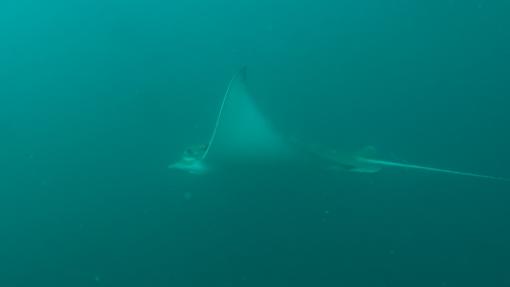BULL RAYS, COMMON STINGRAYS AND SEA EAGLE RAYS... SPECIAL MEETINGS IN THE MUSSEL FARMS OF THE GULF OF TRIESTE
Thanks to the underwater monitoring carried out by MPA Miramare researchers for the Interreg Poseidone Project, rays such as bull rays, stingrays and sea eagle rays continue to be sighted between the nature reserve and the mussel farms along the coastline of Trieste, Italy.
These sightings have also been reported by local mussel farmers and seem to be more frequent at this time of year. Early summer is in fact their breeding season, which may explain some unusual behaviour that has been observed several times in recent years, such as repeatedly rubbing against the mussel rows.
The increase in their numbers is a cause for concern among mussel farmers, who fear that the rays may predate on the mussels that grow along the “socks”.
Although their presence in the farms is well documented, monitoring of the farms has only revealed behaviour related to reproduction.
However, traces of their feeding habits have been observed on the seabed (the classic holes in the sand from which they extract their prey), revealing that the bull rays feed on more than 90% of gastropod molluscs.
According to a very recent study by the Nacionalni inštitut za biologijo, "An insight into the diet of the bull ray (Aetomylaeus bovinus) in the northern Adriatic Sea" (Lovrenc Lipej, Riccardo Battistella, Borut Mavrič and Danijel Ivajnšič, 2025), the dominant species in the diet of bull rays is in fact the gastropod pelican's foot (Aporrhais pespelecani), followed by gibbula (Gibbula magus) and purple dye murex (Bolinus brandaris). These are all molluscs that are characteristic of shifting seabed habitats.
Of the few fish species that end up in their jaws, the most common are small pelagic fish such as sardines (Sardina pilchardus) and Atlantic horse mackerel (Trachurus sp.), which are found in abundance in mussel beds.
The video shows a specimen of Atlantic bull ray (Aetomylaeus bovinus), captured by Amanda Vertovese in Miramare.

